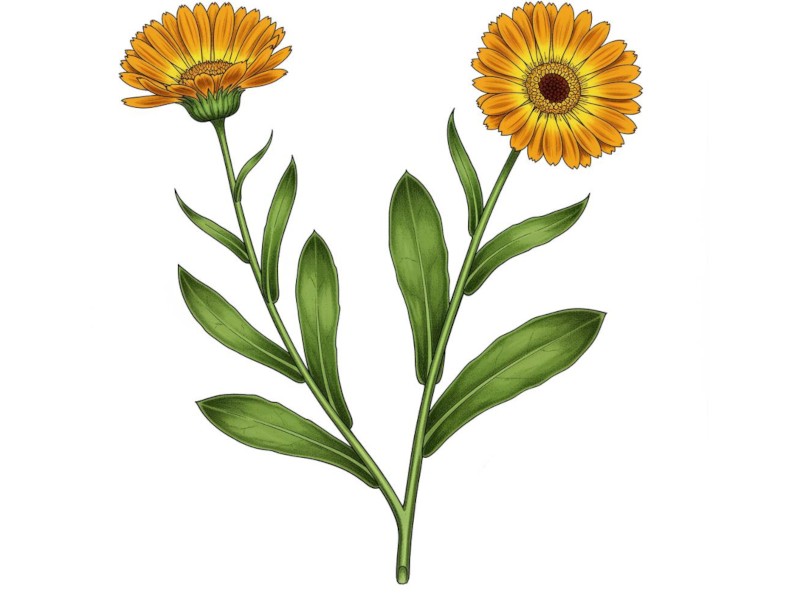Wise Mind Herbs
Evidence-based Herbal Healing
The information on this page has been prepared with reference to published scientific literature, not by a medically qualified expert. It is not medical advice. Any decision to use a supplement or herb-based product is your responsibility. Consult a suitably qualified medical professional, especially if you have underlying conditions. Remember, nothing is for everyone, and not everything sold is what it claims to be. Some things work for some people, some of the time.
Calendula officinalis
Calendula officinalis, commonly known as pot marigold, garden marigold, or simply calendula, is a flowering plant in the family Asteraceae. It should not be confused with ornamental marigolds of the genus Tagetes, French marigold (Tagetes patula), or Mexican marigold (Tagetes erecta), which belong to the same family but have different properties and applications in traditional medicine.

Therapeutic Properties
Calendula has demonstrated several medicinal properties in scientific studies, including anti-inflammatory, antimicrobial, antioxidant, immunomodulatory, wound-healing, and anti-cancer activities. These properties are attributed to various bioactive compounds including flavonoids, carotenoids, terpenoids, and essential oils.
Conditions Treated or Alleviated
- Wound healing: Calendula promotes wound healing by stimulating tissue regeneration and epithelialization.
- Skin inflammation: Effective in treating dermatitis, eczema, and other inflammatory skin conditions.
- Oral mucositis: Reduces severity in cancer patients undergoing chemotherapy or radiotherapy.
- Diaper dermatitis: Calendula-based ointments show efficacy comparable to standard treatments.
- Vaginal infections: Antimicrobial and anti-inflammatory properties help treat vaginal yeast infections.
- Menstrual discomfort: May help alleviate menstrual pain and regulate cycles.
- Conjunctivitis: Calendula eye drops can reduce ocular inflammation.
- Gastrointestinal disorders: Limited evidence suggests benefits for gastritis and colitis.
It's important to note that while these applications have some scientific backing, many studies have methodological limitations, and the evidence varies in strength across different conditions.
Recommended Dosages
Dosages vary depending on the preparation form and condition being treated. Standard dosages from clinical studies include:
- Topical preparations: 2-5% calendula extract in ointments, creams, or gels applied 1-3 times daily.
- Oral consumption (tea): 1-2 g of dried flowers steeped in 150 ml of hot water, up to three times daily.
- Tinctures: 2-4 ml (1:5 in 90% alcohol) three times daily.
- Standardized extracts: Products standardized to contain 0.3-0.8% flavonoids, calculated as hyperoside.
Most clinical studies have used topical formulations containing 2-10% calendula extract, though standardization of active compounds varies widely between preparations, making dose comparisons difficult.
Side Effects and Contraindications
- Allergic reactions: Individuals with known allergies to plants in the Asteraceae family (including ragweed, chrysanthemums, marigolds, and daisies) may experience allergic reactions.
- Pregnancy and lactation: Insufficient safety data for oral use during pregnancy; topical use is generally considered safe.
- Drug interactions: Theoretical potential for interactions with sedatives and medications metabolized by the liver, though clinical significance is uncertain.
- Hypotension: High doses may potentially lower blood pressure.
Calendula is generally recognized as safe (GRAS) by the FDA for food use, and topical preparations typically have minimal side effects beyond potential allergic reactions.
Studies on Higher Dosages
Research on doses significantly above the recommended therapeutic range is limited. Animal toxicity studies have shown that calendula has a high safety margin, with oral LD50 values exceeding 5 g/kg body weight in rodents. However, significant knowledge gaps exist regarding long-term human consumption at high doses. No clear additional benefits have been documented with topical preparations exceeding 10% concentration, while the risk of irritation may increase. The research focus has been primarily on establishing minimum effective doses rather than maximum beneficial doses, representing a notable gap in the current literature.
References
Auh, J. H., & Madhavan, J. (2021). Protective effect of a mixture of marigold and rosemary extracts on UV-induced photoaging in mice. Biomedicine & Pharmacotherapy, 135, 111178.
Deka, B., Bhattacharjee, B., Shakya, A., Ikbal, A. M. A., Goswami, C., & Sarma, S. (2021). Mechanism of action of wound healing activity of Calendula officinalis: a comprehensive review. Pharmaceutical and Biosciences Journal, 28-44.
Dhingra, G., Dhakad, P., & Tanwar, S. (2022). Review on phytochemical constituents and pharmacological activities of plant Calendula officinalis Linn. Biological Sciences, 2(2), 216-228.
Egeli, D. (2022). Calendula officinalis L. In Novel Drug Targets With Traditional Herbal Medicines: Scientific and Clinical Evidence (pp. 49-71). Cham: Springer International Publishing.
Ferreira, A. S., Macedo, C., Silva, A. M., Delerue-Matos, C., Costa, P., & Rodrigues, F. (2022). Natural products for the prevention and treatment of oral mucositis—a review. International Journal of Molecular Sciences, 23(8), 4385.
Shahane, K., Kshirsagar, M., Tambe, S., Jain, D., Rout, S., Ferreira, M. K. M., ... & Lima, R. R. (2023). An updated review on the multifaceted therapeutic potential of Calendula officinalis L. Pharmaceuticals, 16(4), 611.
Sharma, S., & Kumari, K. (2021). An overview on Calendula officinalis Linn.:(pot marigold). Journal of Advanced Scientific Research, 12(03 Suppl 2), 13-18.
Tahami, S. R., Nemati, N. H., Keshvari, H., & Khorasani, M. T. (2022). In vitro and in vivo evaluation of nanofibre mats containing Calendula officinalis extract as a wound dressing. Journal of Wound Care, 31(7), 598-611.